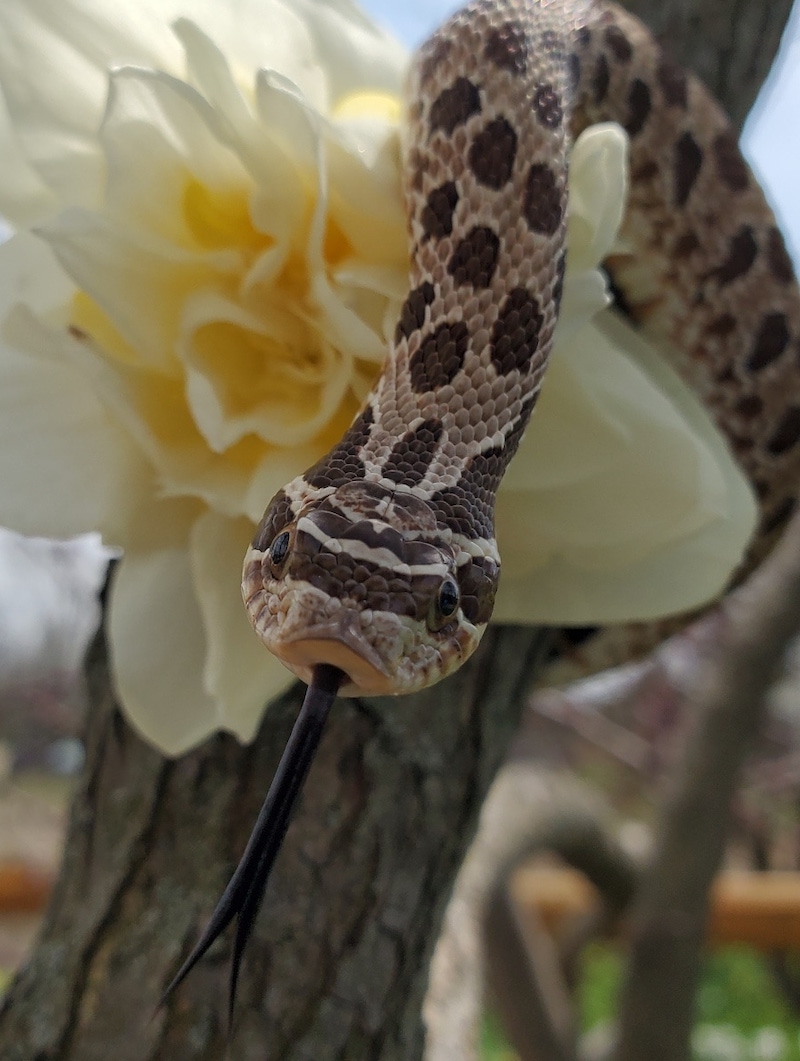Western Dusky Hognose Snake
Heterodon nasicus gloydi
Description
Hognose snakes are small to medium-sized snakes with stout bodies. The pattern on individuals is highly variable. This species can be identified by its upturned rostral (nose) scale, which gives it a pig-nosed appearance.
Size
Adults are rarely longer than 15-20 inches (38.1-50.8 centimeters), with males being smaller than females.
Adaptations
- The modified rostral scale of this species is an adaptation that allows the snakes to be great burrowers.
- When threatened, hognose snakes may flatten their necks (like a cobra), hiss, and make bluff strikes (striking with mouth closed). If further harassed, they will play dead, flipping themselves over on their backs. Some will even open their mouths and stick out their tongues!
Diet
In the wild, western hognose snakes feed predominately on small amphibians and lizards. Occasionally, they may also eat rodents. The hognose snake at Cosley Zoo is fed weekly, alternating between mice and Reptilinks (a commercially prepared reptile diet).
Reproduction
These snakes are polygamous; females will breed with more than one male throughout the breeding season to ensure fertilization. Males will also breed with multiple females. Breeding season for this species occurs in the spring and summer. Hognose snakes are oviparous, with females laying 4-23 eggs in an underground nest. Gestation of the eggs is approximately 60 days. Hatchlings are anywhere from 5-9 inches (12.7-22.9 centimeters) long. This species takes approximately two years to reach sexual maturity.
Shelter and Space Needs
Western hognose snakes are found from southern Canada throughout the United States to Southern Mexico. Their range in the US is bordered to the west by Colorado and Wyoming, and in the east by Illinois. They are often found in habitats with sandy or gravelly soils, including prairies, river floodplains, scrub and grasslands, semi-deserts, and some semi agricultural areas. Hognose snakes use burrows created by small mammals to rest in and to help them regulate their body temperature.
Life Expectancy
In the wild, western hognose snakes have a lifespan of 9 to 19 years, with an average of 14 years. In human care, their lifespan ranges from 15 to 20 years.
Relationship With Man
Conversion of prairie habitat to agricultural use has caused local population declines of this species, but overall, this has not caused a significant threat to the species. The mild temperament of this species makes it an ideal pet. These snakes are also an important part of the food web, controlling toad populations.
Fun Facts
- Hognose snakes possess potentially irritating saliva that may cause symptoms like slight swelling and itching in humans. There is debate on whether this species is considered venomous or nonvenomous.
- Toads are the main food item of this species, making up nearly 80 percent of a hognose snake’s diet in certain regions. When being eaten, toads will swell their bodies in order to make themselves too big to swallow. Western hognose snakes counter this by using their rear fangs to puncture the toads if they try to inflate. The snakes’ enlarged adrenal glands also create enough adrenalin to counteract the toxins found in the toads’ skin.
- Hognose snakes brumate (enter a state of inactivity or torpor) underground during the winter months.
- These snakes are crepuscular, which means that they are most active in the early morning and late evening.







